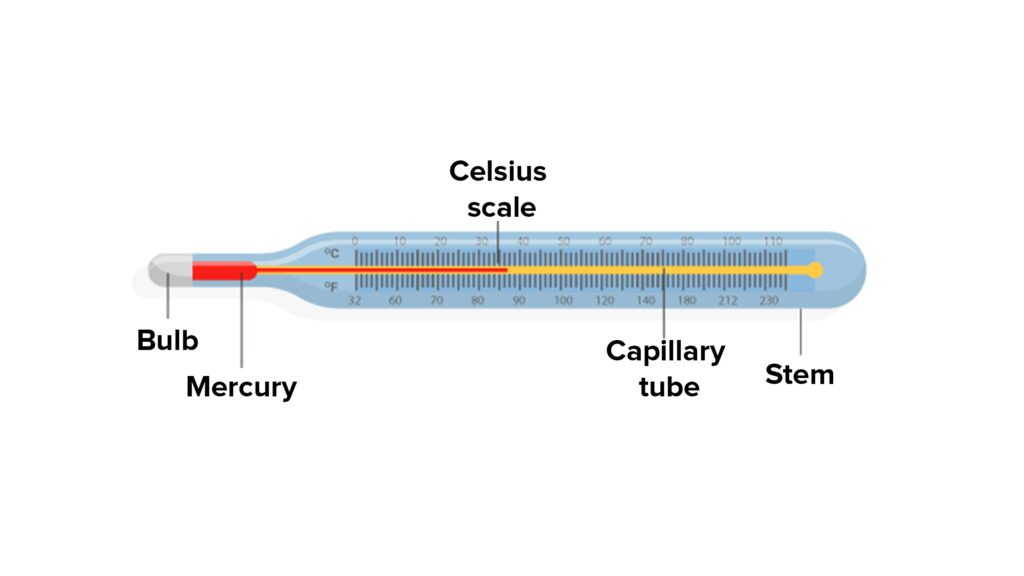Table of Contents
A medical thermometer / clinical thermometer is a device used to measure body temperature. There are so many parts of thermometer.
A glass thermometer have; A stem (long part) and bulb (which contains a small amount of mercury).
Thermometer parts
There are some parts of clinical thermometer

Part of the clinical thermometer
1. Stem
The stem is a long part of the glass thermometer.
2. Mercury bulb
The bulb of the clinical thermometer is circular to deposit the mercury and is usually made of stainless steel. The glass thermometer’s bulb, which serves as a reservoir to hold the mercury, is located at its lowest point. It contains a small amount of mercury. Mercury is a metal, at simple temperatures it occurs in fluid form. Mercury spreads in summer response. If the temperature is high then the mercury in the bulb goes up the capillary hose. The mercury leaves the bulb, when the temperature rises and when the temperature falls, the mercury accumulates inside the bulb.
3. Capillary tube
Capillary or stem is the tube of mercury of mercury that causes mercury to flow. The capillary tube is present inside the glass thermometer, and it is attached to the bulb. The capillary tube mercury thermometer has a long cylindrical tube which is attached to the bulb. When the temperature rises, the mercury flows upwards in the capillary. Where the capillary tube ends, then known as the expansion chamber.
4. Expansion Room
The mercury thermometer’s expansion chamber is located at the capillary’s top. The work of the expansion room is to make a large amount. If the maximum temperature is exceeded the scale, then the mercury can fill.
5. Scale Lines
The thermometer contains the scale line similar length (degree) divisions that are marked on the thermometer that indicate the units of measurement. It depends on the type of thermometer that can be ° F or ° C. When the temperature rises, the mercury inside the bulb rises up and goes down when it cools down. The scale line suggests how far the mercury climbs and goes down, reflects the level of temperature temperature on the body of the thermometer.
6. Tighten
When the reading is being taken, the contraction in the thermometer prevents the mercury from flowing into the bulb.
The tight part is narrow than the stem; This causes the mercury to slow down and gives the user the required time to reach the temperature.
Thermometer type
There are different types of thermometers–
- Digital Thermometer
- Ear (or tympanic) thermometer
- Infrared Thermometer
- Strip-type thermometer
- Mercury thermometer
- App-based thermometer
- Pacifier thermometer
Digital Thermometer
Digital thermometers work using heat sensors that determine body temperature and display numerals on the digital screen. Digital thermometer can be used to take temperature readings in the mouth, rectum or adjacent. The oral temperature can be measured by either a digital or mercury thermometer.





Ear (or tympanic) thermometer
Ear thermometer/ tympanic thermometer measures the temperature inside the ear canal through infrared ray technique. It is poured into the child’s ear.





Infrared Thermometer
Infrared thermometers use infrared scanners to measure temperature. Infrared thermometers can be used in both forehead and wrist areas. The forehead thermometer uses infrared sensor to measure the temperature of the surface temporary artery.





Strip-type thermometer
Strip-type thermometer is used on the forehead. A temperature strip/plastic bandage thermometer is a type of thermometer; Which contains heat-sensitive material in the plastic strip which changes the color to indicate different temperatures.





Mercury thermometer
The mercury thermometer is the mercury-in-glass thermometer. Do not use mercury thermometer; They can break down, leaving small pieces of glass and highly poisonous mercury.
App-based thermometer
Smartphone apps use temperature sensors in the phone to show temperature near your phone.
Pacifier thermometer
A Pacifier thermometer helps in measuring body temperature in infants. If the baby has fever, its color gradually turns blue to red, which reflects fever.





Use of thermometer
A thermometer is used to measure body temperature.
How to disinfect clinical thermometer?
Clean your thermometer with rubbing alcohol or lukewarm soap water before and after use, then wash with cold water. The clinical thermometer should be kept in a safe place away from the child’s reach.
Disinfection rules
Clean the thermometer in a single stroke with a cotton swab or cotton swab immersed in alcohol.
Before use
In alcohol Dipped the thermometer from the immersed alcohol swab or cotton ball and rubbed the bulb with a stem in one stroke.
After use
Disinfected the thermometer with a cotton swab or cotton ball immersed in alcohol and rubbed the stem with a bulb in a shock.
Read Also
- Thermometer | Types of Thermometer
- Pressure gauge thermometer | Liquid in metal Thermometer:
- Mercury Thermometer | Liquid in Glass Thermometer
- Bimetallic Thermometer :Working Principle, Types, Construction, Advantage/Disadvantage & Applications